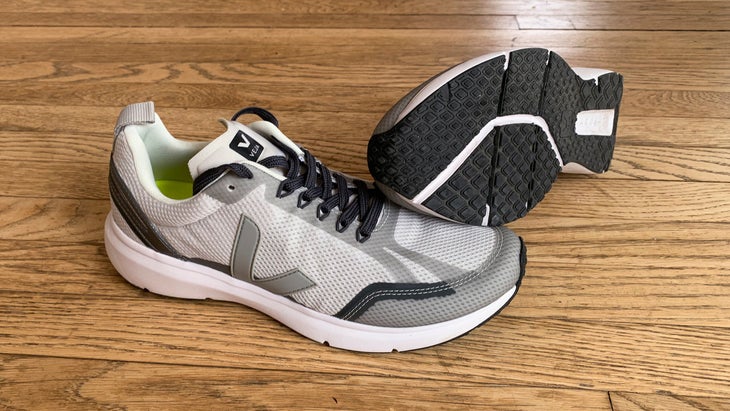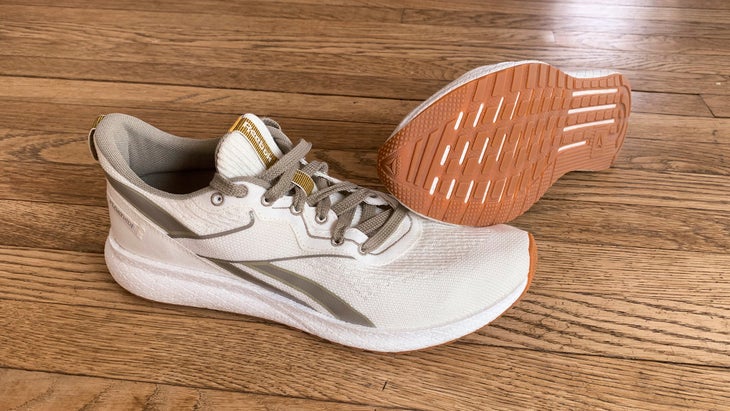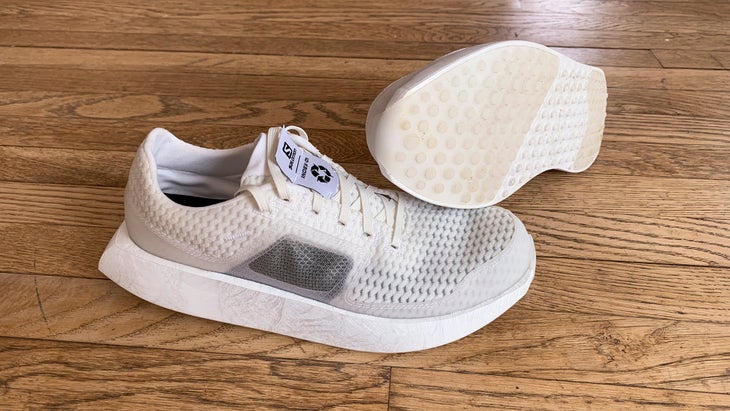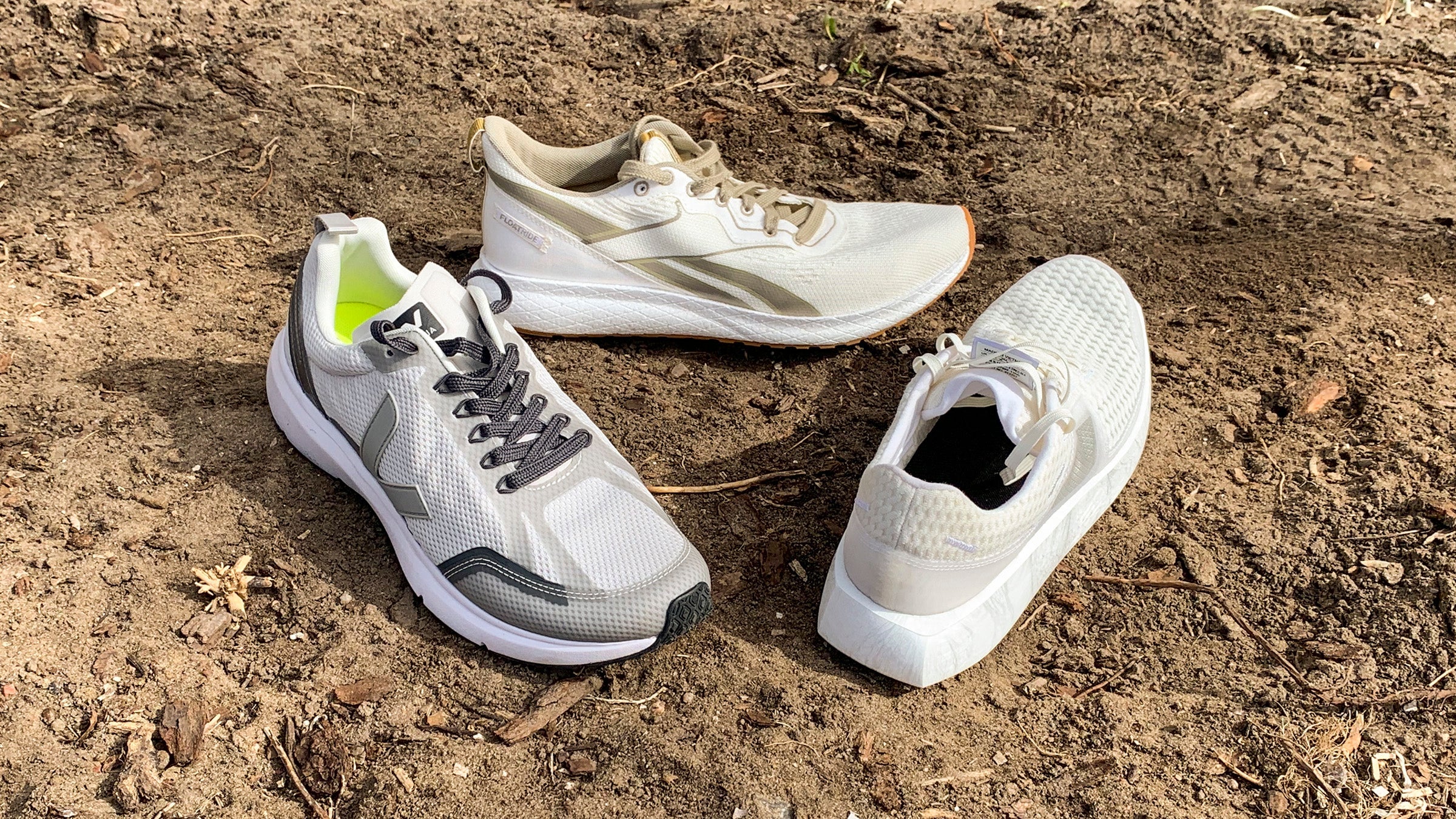It’s not easy being green, especially when it comes to running shoes. A and creating models that propose to be major steps toward a post-petroleum, fully recycled future. These eco-friendly running shoes are made of a large percent of plant-based and recycled materials and are specifically designed for ease of recycling. They even look environmentally aware, with their neutral, un-dyed tones. But the big question is: how do they run?
We had a small group of testers run in each model, and the consensus was that the shoes are… adequate. None of them have anything wrong with them, but they didn’t wow. No one wanted to put many miles on them, with one tester saying, “I abandoned them after two runs,” and another nicely summarizing the group’s sentiments: “I feel great and stylish walking around in these — but they feel more like fashionable sneakers rather than running shoes.”
The word “clunky” came up a few times; a feeling that the parts didn’t fit together quite right, and that the parts themselves were all rather basic compared to today’s expectations. In fact, they reminded testers of early running models from the first running boom of the ’70s, not today’s highly-engineered, fine-tuned footwear.
Remember, however, those early models were prototypes, using new materials in novel ways. Shoes got better quickly. Similarly, these green materials will require time to perfect. These models are a work in progress, and already companies are releasing second models that promise to fit and ride better.
“If there were an ecofriendly shoe that ran as well as conventional models, I would be happy to pay a premium for it,” said tester Scott Douglas, “No such model exists yet.” We await the Tesla-esque breakthrough in green performance shoes. For now, we applaud these efforts, and eagerly support them by endorsing these models — as fine for short, easy runs, and awesome for casual shoes.
Veja Condor 2

What’s Green:
This shoe, from a founded in 2005, is manufactured in “dignified conditions” in Brazil, and made with multiple plant-based or recycled materials:
- Outsole: 30% Amazonian rubber, 31% rice waste
- Midole: 46% sugar cane, 8% banana oil
- Insole: 51% sugar cane, 21% recycled bottles
- Upper, Lining and Laces: 100% recycled plastic bottles
Specs:
Weight: 10.6 oz (M)
Stack Heights: 27mm heel/ 17 mm forefoot
Drop: 10mm
Price:
How They Run
Pros: Everyone was a fan of the colors and found the shoes stylish, even “super rad.” The uppers are flexible, breathable and “generally comfortable,” with plenty of volume. And the ride is “a very secure, stable feeling,” with very little sloppy squish, providing solid ground feel and not getting in the way of an efficient stride.
Cons: Testers described the ride as, “rather flat,” “not lively at all,” and “rather generic.” The feel reminded us of the first-era EVA running shoes circa mid 1975s – a firm, somewhat stiff cushioning with just a hint of cushion. Some felt the upper was a bit clunky, not molding well to the foot. One tester described it as, “tight in some spots and quite loose in others — and somewhat randomly so.”
Available soon from Veja: the Marlin, with a 6mm drop, somewhat softer midsole, more curved shape, and slightly higher percentage of bio-based and recycled materials.
Reebok Forever Floatride Grow

What’s Green:
Part of Reebok’s goal to have 100% sustainable products by 2030 by using recycled materials and reduce the use of petroleum-based plastics in footwear by making products with plants, the GROW is made with 59% USDA Certified bio-based content including:
- Outsole: Natural rubber
- Midole: Castor bean oil
- Insole: Algae
- Upper: Biodegradable eucalyptus bark
Specs:
Weight: 9.3 oz (M), 7.5 oz (W)
Stack Heights: 26mm heel / 17mm forefoot
Drop: 9mm
Price:
How They Run
Pros: The GROW impresses stylistically, with its simple, clean lines and earthy tones and textures. “Aesthetically this shoe is awesome!” said one tester. “It’s beautiful and the fabric is soft and clean.” The shoe also has a flexible, close-to-the-ground feel underfoot, which some testers found delivered a smooth, unobtrusive, and firm ride they appreciated for its minimal cushioning, responsiveness and proprioception.
Cons: Testers found the lacing rather basic, making it hard to get the upper to hold their feet snuggly enough for comfortable running. And the sockliner is flat, stiff and loose-fitting, making the underfoot feel a bit clunky (this improved with some break-in, which we’re not used to needing with modern shoes). Some testers found the foam too firm and stiff, lacking the cush and responsiveness we’ve come to expect. “They felt more like court shoes or walking shoes than performance running shoes,” said one.
Just Released from Reebok: , which promises “full performance running feel and delivers responsive and lightweight cushioning.”
Salomon Index.01

What’s Green:
Designed to be easily dissembled and recycled, the Index.01 is made of only two materials — recycled polyester upper and TPU midsole and outsole — held together with a water-based glue. Runners can print a free shipping label to return the shoes for recycling at the end of their lifecycle.
Specs:
Weight: 10oz (US 9M)
Stack Heights: 28.5mm heel / 19.5mm forefoot
Drop: 9mm
Price:
How They Run
Pros: The clean, futuristic styling made these a coveted item among testers (and their teenage children) as a casual shoe for daily wear. When taken on a run, the TPU midsole is tuned to be firm and fast. Testers enjoyed how it got them off the ground quickly, with just enough deflection to ease pressure under foot bones before a lively bounce back. The upper is mostly a soft, flexible, breathable mesh that holds simply without getting in the way.
Cons: We found that the rear outrigger and square edges create levers that made heel landings a bit harsh. Testers also reported that the shape is narrow and a bit unusual, making it hard to tighten the upper over the foot comfortably, particularly where the rigid mesh window on the outside of foot wrapped over the instep. And, compared to today’s performance shoes, one tester said, “the interface between upper and sole is not as nuanced as I’ve come to expect.”


